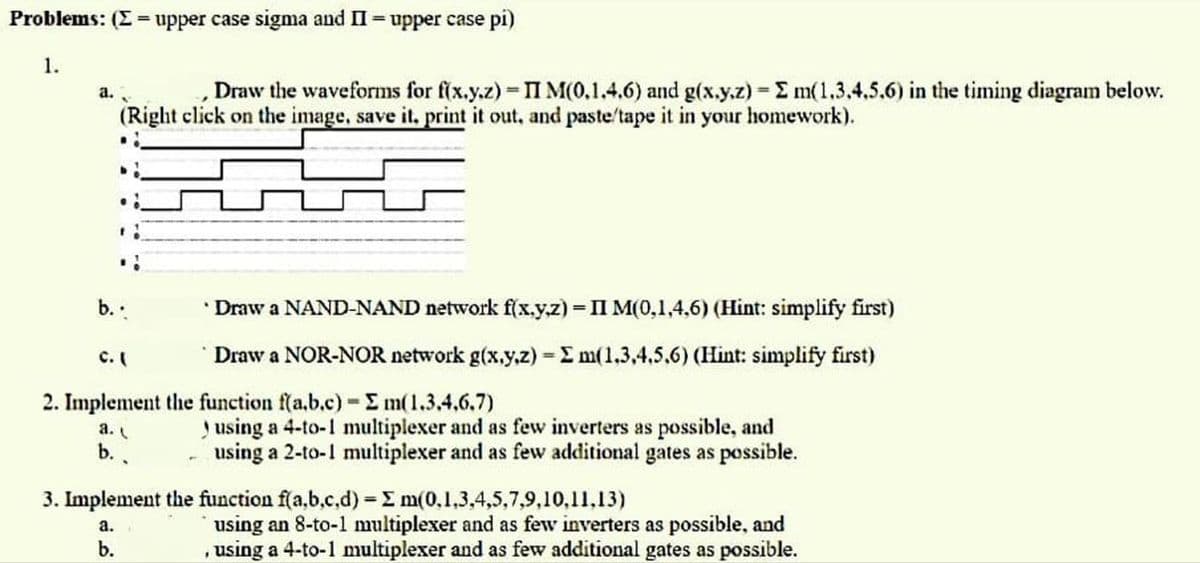Problems: (Σ - upper case sigma and II - upper case pi) 1. a. Draw the waveforms for f(x.y.z)-II M(0,1.4.6) and g(x,y,z) - E m(1.3.4.5.6) in the timing diagram below. (Right click on the image, save it, print it out, and paste/tape it in your homework). b... C. ( Draw a NAND-NAND network f(x,y,z) = II M(0,1,4,6) (Hint: simplify first) Draw a NOR-NOR network g(x,y,z) = m(1.3.4.5.6) (Hint: simplify first)
Problems: (Σ - upper case sigma and II - upper case pi) 1. a. Draw the waveforms for f(x.y.z)-II M(0,1.4.6) and g(x,y,z) - E m(1.3.4.5.6) in the timing diagram below. (Right click on the image, save it, print it out, and paste/tape it in your homework). b... C. ( Draw a NAND-NAND network f(x,y,z) = II M(0,1,4,6) (Hint: simplify first) Draw a NOR-NOR network g(x,y,z) = m(1.3.4.5.6) (Hint: simplify first)
Database System Concepts
7th Edition
ISBN:9780078022159
Author:Abraham Silberschatz Professor, Henry F. Korth, S. Sudarshan
Publisher:Abraham Silberschatz Professor, Henry F. Korth, S. Sudarshan
Chapter1: Introduction
Section: Chapter Questions
Problem 1PE
Related questions
Question

Transcribed Image Text:Problems: (= upper case sigma and II = upper case pi)
1.
a.
=
Draw the waveforms for f(x.y.z) - II M(0,1.4.6) and g(x,y,z) - E m(1,3,4,5,6) in the timing diagram below.
(Right click on the image, save it, print it out, and paste/tape it in your homework).
d!
.!
1:
b...
a.
b.
Draw a NAND-NAND network f(x,y,z) = II M(0,1,4,6) (Hint: simplify first)
Draw a NOR-NOR network g(x,y,z) - Σ m(1.3.4.5.6) (Hint: simplify first)
=
C. (
2. Implement the function f(a.b.c) - Σm(1.3.4.6.7)
using a 4-to-1 multiplexer and as few inverters as possible, and
using a 2-to-1 multiplexer and as few additional gates as possible.
3. Implement the function f(a,b,c,d) = m(0,1,3,4,5,7,9,10,11,13)
a.
b.
using an 8-to-1 multiplexer and as few inverters as possible, and
, using a 4-to-1 multiplexer and as few additional gates as possible.
Expert Solution
This question has been solved!
Explore an expertly crafted, step-by-step solution for a thorough understanding of key concepts.
Step by step
Solved in 4 steps with 3 images

Knowledge Booster
Learn more about
Need a deep-dive on the concept behind this application? Look no further. Learn more about this topic, computer-science and related others by exploring similar questions and additional content below.Recommended textbooks for you

Database System Concepts
Computer Science
ISBN:
9780078022159
Author:
Abraham Silberschatz Professor, Henry F. Korth, S. Sudarshan
Publisher:
McGraw-Hill Education

Starting Out with Python (4th Edition)
Computer Science
ISBN:
9780134444321
Author:
Tony Gaddis
Publisher:
PEARSON

Digital Fundamentals (11th Edition)
Computer Science
ISBN:
9780132737968
Author:
Thomas L. Floyd
Publisher:
PEARSON

Database System Concepts
Computer Science
ISBN:
9780078022159
Author:
Abraham Silberschatz Professor, Henry F. Korth, S. Sudarshan
Publisher:
McGraw-Hill Education

Starting Out with Python (4th Edition)
Computer Science
ISBN:
9780134444321
Author:
Tony Gaddis
Publisher:
PEARSON

Digital Fundamentals (11th Edition)
Computer Science
ISBN:
9780132737968
Author:
Thomas L. Floyd
Publisher:
PEARSON

C How to Program (8th Edition)
Computer Science
ISBN:
9780133976892
Author:
Paul J. Deitel, Harvey Deitel
Publisher:
PEARSON

Database Systems: Design, Implementation, & Manag…
Computer Science
ISBN:
9781337627900
Author:
Carlos Coronel, Steven Morris
Publisher:
Cengage Learning

Programmable Logic Controllers
Computer Science
ISBN:
9780073373843
Author:
Frank D. Petruzella
Publisher:
McGraw-Hill Education